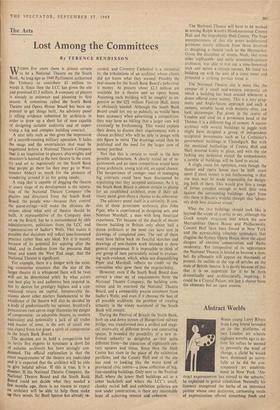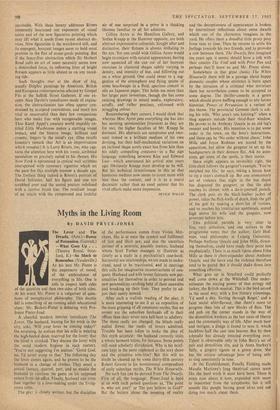Abstract Worlds
inevitable. With these breezy addresses Rivers immensely heartened our exponents of visual satire and of the new figurative painting which may lift what it needs from recent abstract de- vices. New figuration is the watchword still, and its emergent, buoyant images seem to hold most promise in the flux of avant-garde painting. But if the fancy-free abstraction which Sir Herbert Read calls an art of inner necessity seems now a diminished force, its inflowing litter of bright flotsam appears as little abated as on any reced- ing tide.
Such thoughts rear at the show of big, usually Delphic paintings by American, British and European contemporaries selected by Gimpel Fits at the Suffolk Street Galleries. If one ex- cepts Alan Davies's tumultuous mode of expres- sion, the abstractionists too often appear con- strained by accepted conventions, and much less vital or resourceful than their few companions here who make free with recognisable images. Thus Karel Appel's creature world impishly en- titled Little Mushroom makes a startling visual impact, and the bizarre image, brilliant and creamy, lingers in the mind's eye. (One recalls lonesco's remark that Art is an improvisation which remains.) It is Larry Rivers, too, who cap- tures the attention here with his ironic, scribbled naturalism so precisely suited to his themes. His New York is epitomised in cynical wall scribbles interspersed with summary vignettes which set the pace for this multiple manner a decade ago. The liveliest thing indeed is Rivers's portrait of David Sylvester, half his figure and one eye scrubbed over and the seated posture redefined with a cursive brush line. The resultant image of an oracle with the compressed and bodeful air of one surprised in a privy is a thinking likeness familiar to all his admirers.
Gillian Ayres at the Hamilton Gallery, and Stefan Knapp at the Hanover opposite, are both abstract expressionist colourists. Sought after and distinctive, their flotsam is always titillating to the eye. Yet one could wish Gillian Ayres would begin to conjure with natural appearances, having now squeezed all she can out of her buoyant exercises in clustered shapes subtly varying in density, and intensity of hue, and billowing out on a white ground. One could swear to a sug- gestion of the atmosphere and flying spume of some beachscape in a fluid, spacious conceit in oils on Japanese paper. This holds me more than her larger pure inventions, though she has some enticing drawings in mixed media, exploratory, scruffy, and rather precious, enlivened with straggling colour. Remembering their careers, I would think that whereas Miss Ayres puts everything she has into her seeming spontaneities (transient as they are for me), the higher faculties of Mr. Knapp lie dormant. His abstracts are sumptuous and reso- nant indeed in a brilliant medium of his own devising, but their half-mechanical variations on an inclined shape surely exact less from him than his oddly compelling creatures—in a flat sign language something between Klee and Edward Lear—which announced his arrival nine years ago. Obviously Knapp must develop as he will. But his technical inventiveness in this or that luminous medium now seems to count more with him than the content, and it is as a mural decorator rather than an easel painter that his vivid effects make more impression.
NEVILE WALLIS



































 Previous page
Previous page